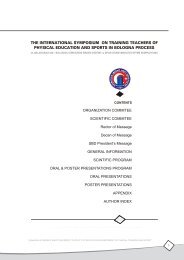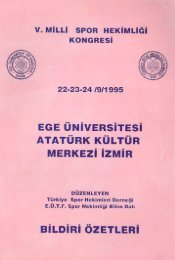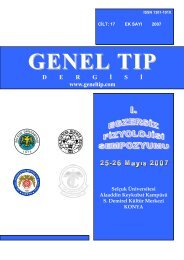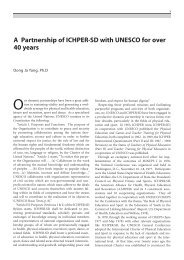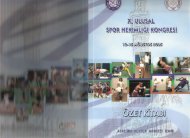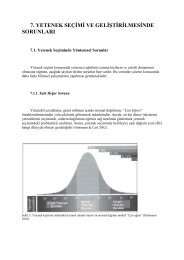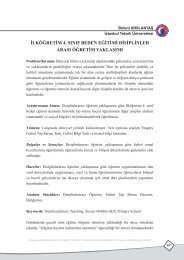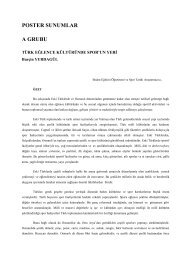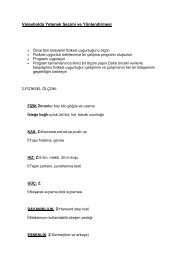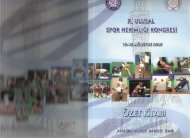KARDÄ°YORESPÄ°RATUVAR EGZERSÄ°Z TESTLERÄ° ... - Spor Bilim
KARDÄ°YORESPÄ°RATUVAR EGZERSÄ°Z TESTLERÄ° ... - Spor Bilim
KARDÄ°YORESPÄ°RATUVAR EGZERSÄ°Z TESTLERÄ° ... - Spor Bilim
You also want an ePaper? Increase the reach of your titles
YUMPU automatically turns print PDFs into web optimized ePapers that Google loves.
7.ULUSLARARASI SPOR BİLİMLERİ KONGRESİ27-29 EKİM 2002KONGRE - PANELLERbook (2000) "Emotions in <strong>Spor</strong>t", crediting the contribution of emotions other than merely anxiety to thisparticular psychological construct.According to this theory both high jumpers possessed an IZOF and did their best to be within itsboundaries prior and during to the Olympic final. However, due to the adverse circumstance, one was not ableto while the other, by virtue of his foresight and careful preparations, could. Stones', upon approaching the mostvital stages of the competition, was too far removed to the right of his personal IZOF, not being able to producehis normal abilities. His rival, it so seems, managed to maintain his IZOF for the entire duration of the contestand perform at his best.In a recent study, Robazza, Bortoli and Nougier, (2002), measured the emotional IZOF as it related tothe performances of elite level archers. In their findings they did not only strengthened the validity of this modelas a predictor of performance but also demonstrated that athletes are able to identify and adopt individualpatterns of facilitating and inhibiting emotions varying in content and intensity. The authors advocated thatfarther research in the area will assist athletes' awareness of their own ideal psychophysical state enablingthem faster, more accurate, entry to their IZOF and better emotional control.Annesi, (1998) conducted a two phase experimental study with young elite tennis players. During the firstphase, by means of the CSAI-2 test he established for each tennis player three IZOFS: one for cognitive anxietyone for somatic anxiety and one for self confidence. In the second stage of the study, each tennis playermastered psychological skills to increase or decrease specific anxiety components. The players were asked toself administer the CSAI-2 test prior to on the road tournament matches to promptly identify possible deviationsfrom their three pre determined IZOF(S). Once deviation from an IZOF was identified the player had to engagethe appropriate remedial psychological skill. Follow up of forthcoming tournaments results did indicatedsignificant improvements. Such studies point future directions for sport anxiety research, not merely theory butalso practical application aimed at performance enhancement and consistency.Concluding RemarksAnxiety has and will always be an integral part of competitive sport. When athletes are asked to performat their best in front of many thousands spectators in the stadium and many more millions television viewersanxiety is unavoidable. The question is therefore one of coping and controlling rather than eliminating. To dothat we must first understand the nature of Anxiety and its various components, how these interact to effectathletic performance, only then can we design practical methods and mental skills to assist performers. Takinginto consideration that sport is turning by the day more professional, that financial benefits of winning areconstantly mushrooming and the intensification of social and personal meaning of winning or losing, we mayexpect yet further increases in sport related anxiety.I therefore predict that, in the future, more and more athletes will approach sport psychologists forassistance in such matters realizing that being physically fit or physiologically prepared is only necessary but notsufficient condition for quality performance. On that particular evening in Montreal, Dwight Stones had it allphysically and under normal conditions no other jumper in the entire world could touch him. But, he mentally hewas not prepared or skilled to cope with "abnormal" conditions. Washola, by way of his specific "Model training"was mentally immune and, in spite of all odds and disturbances, able to produce excellence at the right time andthe right place. Today, twenty six years later, we certainly know much more about anxiety and sport, manyresearchers, both theoretical and applied, have contributed to that. Do we know enough? I am not certain; dowe have the right answers for the athletes? Only they will have to answer it by approaching us more often foradvice and support.329



